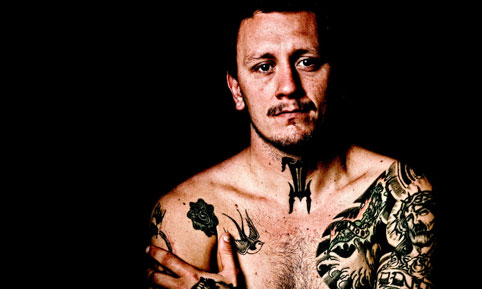
‘Drawing has always been part of my life. I’ve always drawn, since I was little. My dad had a bar on the beach, and my friends were all surfers. Everyone had a tattoo. There was a tattooist there named Hélio Tattoo, and that was when I saw tattooing for the first time. I was 8.
‘I started tattooing when I was about 17. At the time, I was drawing mostly to practice. Then I took some classes in drawing and sketching, in Porto Alegre, my hometown. I used to use pastels a lot, and from there I started to get involved with street art. I used spray paint, and also worked with airbrushing – I painted a lot of surfboards for friends. After that phase, I started working on canvases. I bought some materials and just started painting – I’ve worked with collages, acrylics and oils. Sometimes I’ll paste a collage in the background.
‘I started out painting things related to tattooing and street art, and I still do now. I was looking for a style of painting – something that I could develop, and I think I can say I found a line of work that completes me.’
‘I have a fascination with old things, old photographs, and I’ve always admired classical painting. I wanted to do some old-fashioned painting combined with the history of tattooing. I get photos from the 1920s and 1930s and reproduce them, but I don’t try to make them realistic – I make them simpler, but keep what I think is the most important aspect – the expression and the life of the subject. First, I’ll work on the person and then I’ll tattoo him – I draw the person, the body, paint the skin tone and such, and then I do the tattoo. It’s almost a ritual.
‘In the time my subjects lived in, tattoos were considered taboo. These people were on the margins of society – there were clubs where they’d meet, but it was all underground. The title of my exhibition, ‘Tabu’ (‘Taboo’), is intended to get people thinking about the people who had tattoos back then, who may have been excluded, experienced prejudice, or been viewed as strange. But they remained faithful to their ideals – they were getting tattooed, each for his own reason, regardless of prejudice.
‘Today, tattoos are more commonplace – they’ve become cool, hip, modern, even if some prejudice still exists. Tattooing’s path from prejudice to fashion leaves you pondering a few things, and that’s something I want to put out there. I paint this because it relates to my work, but it also brings other things to light, beyond tattoos. Prejudice, and how one thing becomes another, how something bad can become cool.



